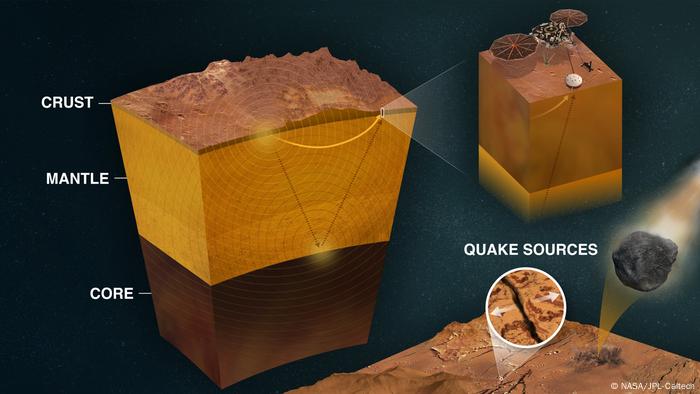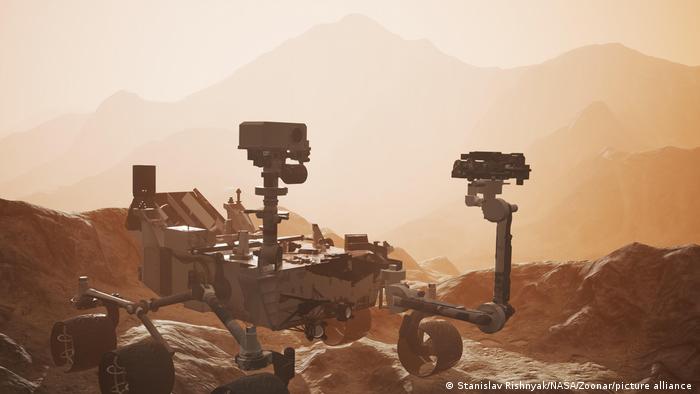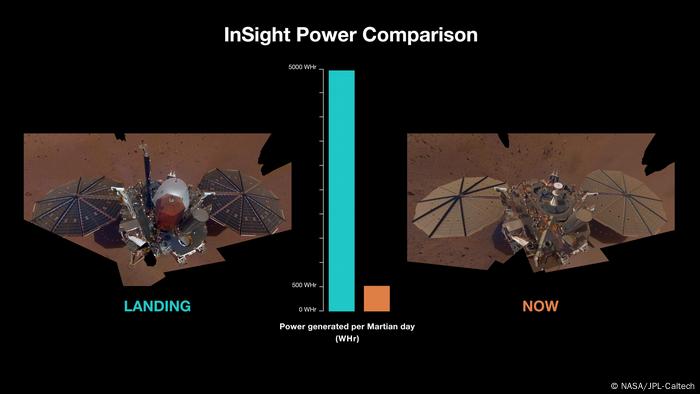Science
InSight mission on Mars begins to say goodbye to Earth – DW (English)

The NASA InSight research mission has provided our first look at the red planet’s interior. Now, the lander is set to power down by December 2022, bringing the four-year-long scientific endeavor to a successful end.
The InSight lander touched down in the Elysium Planitia region of Mars in November 2018 with the goal of studying the planet’s deep interior for the first time.
“We know a lot about the surface of Mars, a lot about its atmosphere and ionosphere, but we don’t know much about what goes on below its surface,” said InSight principal investigator Bruce Banerdt at the start of the mission.
InSight’s primary goal was to better understand how rocky planets are formed and evolved. Equipped with a suite of scientific instruments, it was designed to accomplish the mission’s goals in its first Mars year ― nearly two Earth years.
Now, after a long and successful mission, the InSight Lander will steadily power down, a process that will be complete by the end of 2022.
Listening to Mars rock
The InSight lander had a number of scientific instruments on board to measure geological and meteorological features on Mars.
One of them is a highly sensitive seismometer, which recorded more than 1,300 Mars quakes. These ranged from tiny tremors, barely more than background noise, to a handful of quakes that were stronger than magnitude 4. And recently, InSight registered a magnitude 5 quake, the largest detected on Mars so far.
Seismic waves pass through or reflect off of materials in Mars’ crust, mantle and core. Waves traveling through different materials inside a planet generate different speeds and shapes, which are detected by the seismometer.
“With those vibrations, scientists can take the information to reconstruct all the material that those Mars quakes traveled through, thereby seeing the interior of the planet,” said Elizabeth Barrett, InSight science and instrument operations lead.
Three studies published in Science in July 2021 gave humanity its first insights into the structure of Mars. They found Mars has a 24 to 72 kilometer (15 to 44.7 mile) thick crust, likely enriched in radioactive elements that produce heat.
Below the crust, the mantel consists of one rocky layer, rather than two like Earth has. Mars’ core is very large, roughly 1,830 kilometers in radius, and filled with an iron-nickel liquid.
“By measuring the detailed structure of the interior of Mars, we get a snapshot of what it looked like 4.5 billion years ago,” said Banerdt.
Weather reports on Mars
The team also set out to make a detailed record of the weather on Mars. The onboard weather station allowed meteorologists to study the weather at the landing site and relate that to the climate changes on Mars.
The InSight lander was going to measure the surface temperature with its onboard heat flow and physical properties probe. The probe was supposed to drill five meters (16.4 feet) below ground level and measure fluctuations in the surface temperature, however the probe failed to reach that depth.
Still, atmospheric temperatures, pressure, wind speeds and wind directions were successfully recorded with InSight’s weather station.
InSight sent its last weather report from western Elysium Planitia on October 25, 2020, recording a temperature high of -4.4 degrees Celsius (24 degrees Fahrenheit) and a low of -95.4 degrees Celsius (-140 degrees Fahrenheit).
The latest Mars weather updates come from NASA’s Curiosity rover, located about 600 kilometers (373 miles) north of InSight in the Gale crater.
Powering down the mission
After InSight met the goals of its two-year prime mission in late 2020, NASA extended the mission until December 2022.
However, due to dust accumulation on its solar panels, the InSight lander’s electrical power production is dropping. With decreasing power, the team will gradually shut down different instruments until InSight will eventually lose power entirely.
The team were able to buy more time this past summer with an innovative method to clean the solar panels ― using dirt. Using a remote control arm with a scoop attached, they dropped heavy dirt onto the panels, knocking some of the dust off.
Currently, the seismometer is still in operation, but it will be turned off in late summer 2022 to preserve power. This is expected to be the end of the InSight lander’s science operations before the craft’s power levels are so low that it will simply stop responding by the end of 2022.
“InSight has been fantastically successful. We’ve gotten more science than we had ever dreamed we would get. We’ve rewritten the encyclopedia chapter on the interior of Mars,” said Banerdt.
The mission has generated enough data for scientists to analyze for decades to come. Answering questions on Mars’ structure will help shed light on how all rocky planets and satellites form, including Earth and its moon.
But for now, it’s over to NASA’s Curiosity Rover to continue the mission on Mars.
This article has been translated from German
Science
Marine plankton could act as alert in mass extinction event: UVic researcher – Langley Advance Times


A University of Victoria micropaleontologist found that marine plankton may act as an early alert system before a mass extinction occurs.
With help from collaborators at the University of Bristol and Harvard, Andy Fraass’ newest paper in the Nature journal shows that after an analysis of fossil records showed that plankton community structures change before a mass extinction event.
“One of the major findings of the paper was how communities respond to climate events in the past depends on the previous climate,” Fraass said in a news release. “That means that we need to spend a lot more effort understanding recent communities, prior to industrialization. We need to work out what community structure looked like before human-caused climate change, and what has happened since, to do a better job at predicting what will happen in the future.”
According to the release, the fossil record is the most complete and extensive archive of biological changes available to science and by applying advanced computational analyses to the archive, researchers were able to detail the global community structure of the oceans dating back millions of years.
A key finding of the study was that during the “early eocene climatic optimum,” a geological era with sustained high global temperatures equivalent to today’s worst case global warming scenarios, marine plankton communities moved to higher latitudes and only the most specialized plankton remained near the equator, suggesting that the tropical temperatures prevented higher amounts of biodiversity.
“Considering that three billion people live in the tropics, the lack of biodiversity at higher temperatures is not great news,” paper co-leader Adam Woodhouse said in the release.
Next, the team plans to apply similar research methods to other marine plankton groups.
Read More: Global study, UVic researcher analyze how mammals responded during pandemic
Science
Scientists Say They Have Found New Evidence Of An Unknown Planet… – 2oceansvibe News


In the new work, scientists looked at a set of trans-Neptunian objects, or TNOs, which is the technical term for those objects that sit out at the edge of the solar system, beyond Neptune
The new work looked at those objects that have their movement made unstable because they interact with the orbit of Neptune. That instability meant they were harder to understand, so typically astronomers looking at a possible Planet Nine have avoided using them in their analysis.
Researchers instead looked towards those objects and tried to understand their movements. And, Dr Bogytin claimed, the best explanation is that they result from another, undiscovered planet.
The team carried out a host of simulations to understand how those objects’ orbits were affected by a variety of things, including the giant planets around them such as Neptune, the “Galactic tide” that comes from the Milky Way, and passing stars.
The best explanation was from the model that included Planet 9, however, Dr Bogytin said. They noted that there were other explanations for the behaviour of those objects – including the suggestion that other planets once influenced their orbit, but have since been removed – but claim that the theory of Planet 9 remains the best explanation.
A better understanding of the existence or not of Planet 9 will come when the Vera C Rubin Observatory is turned on, the authors note. The observatory is currently being built in Chile, and when it is turned on it will be able to scan the sky to understand the behaviour of those distant objects.
Planet Nine is theorised to have a mass about 10 times that of Earth and orbit about 20 times farther from the Sun on average than Neptune. It may take between 10,000 and 20,000 Earth years to make one full orbit around the Sun.
You may be tempted to ask how an entire planet could ‘hide’ in our solar system when we have zooming capabilities such as the new iPhone 15 has, but consider this: If Earth was the size of a marble, the edge of our solar system would be 11 kilometres away. That’s a lot of space to hide a planet.
[source:independent]
Science
Dragonfly: NASA Just Confirmed The Most Exciting Space Mission Of Your Lifetime – Forbes


NASA has confirmed that its exciting Dragonfly mission, which will fly a drone-like craft around Saturn’s largest moon, Titan, will cost $3.35 billion and launch in July 2028.
Titan is the only other world in the solar system other than Earth that has weather and liquid on the surface. It has an atmosphere, rain, lakes, oceans, shorelines, valleys, mountain ridges, mesas and dunes—and possibly the building blocks of life itself. It’s been described as both a utopia and as deranged because of its weird chemistry.
Set to reach Titan in 2034, the Dragonfly mission will last for two years once its lander arrives on the surface. During the mission, a rotorcraft will fly to a new location every Titan day (16 Earth days) to take samples of the giant moon’s prebiotic chemistry. Here’s what else it will do:
- Search for chemical biosignatures, past or present, from water-based life to that which might use liquid hydrocarbons.
- Investigate the moon’s active methane cycle.
- Explore the prebiotic chemistry in the atmosphere and on the surface.
Spectacular Mission
“Dragonfly is a spectacular science mission with broad community interest, and we are excited to take the next steps on this mission,” said Nicky Fox, associate administrator of the Science Mission Directorate at NASA Headquarters in Washington. “Exploring Titan will push the boundaries of what we can do with rotorcraft outside of Earth.”
It comes in the wake of the Mars Helicopter, nicknamed Ingenuity, which flew 72 times between April 2021 and its final flight in January 2023 despite only being expected to make up to five experimental test flights over 30 days. It just made its final downlink of data this week.
Dense Atmosphere
However, Titan is a completely different environment to Mars. Titan has a dense atmosphere on Titan, which will make buoyancy simple. Gravity on Titan is just 14% of the Earth’s. It sees just 1% of the sunlight received by Earth.
function loadConnatixScript(document)
if (!window.cnxel)
window.cnxel = ;
window.cnxel.cmd = [];
var iframe = document.createElement(‘iframe’);
iframe.style.display = ‘none’;
iframe.onload = function()
var iframeDoc = iframe.contentWindow.document;
var script = iframeDoc.createElement(‘script’);
script.src = ‘//cd.elements.video/player.js’ + ‘?cid=’ + ’62cec241-7d09-4462-afc2-f72f8d8ef40a’;
script.setAttribute(‘defer’, ‘1’);
script.setAttribute(‘type’, ‘text/javascript’);
iframeDoc.body.appendChild(script);
;
document.head.appendChild(iframe);
loadConnatixScript(document);
(function()
function createUniqueId()
return ‘xxxxxxxx-xxxx-4xxx-yxxx-xxxxxxxxxxxx’.replace(/[xy]/g, function(c) 0x8);
return v.toString(16);
);
const randId = createUniqueId();
document.getElementsByClassName(‘fbs-cnx’)[0].setAttribute(‘id’, randId);
document.getElementById(randId).removeAttribute(‘class’);
(new Image()).src = ‘https://capi.elements.video/tr/si?token=’ + ’44f947fb-a5ce-41f1-a4fc-78dcf31c262a’ + ‘&cid=’ + ’62cec241-7d09-4462-afc2-f72f8d8ef40a’;
cnxel.cmd.push(function ()
cnxel(
playerId: ’44f947fb-a5ce-41f1-a4fc-78dcf31c262a’,
playlistId: ‘aff7f449-8e5d-4c43-8dca-16dfb7dc05b9’,
).render(randId);
);
)();
The atmosphere is 98% nitrogen and 2% methane. Its seas and lakes are not water but liquid ethane and methane. The latter is gas in Titan’s atmosphere, but on its surface, it exists as a liquid in rain, snow, lakes, and ice on its surface.
COVID-Affected
Dragonfly was a victim of the pandemic. Slated to cost $1 billion when it was selected in 2019, it was meant to launch in 2026 and arrive in 2034 after an eight-year cruise phase. However, after delays due to COVID, NASA decided to compensate for the inevitable delayed launch by funding a heavy-lift launch vehicle to massively shorten the mission’s cruise phase.
The end result is that Dragonfly will take off two years later but arrive on schedule.
Previous Visit
Dragonfly won’t be the first time a robotic probe has visited Titan. As part of NASA’s landmark Cassini mission to Saturn between 2004 and 2017, a small probe called Huygens was despatched into Titan’s clouds on January 14, 2005. The resulting timelapse movie of its 2.5 hours descent—which heralded humanity’s first-ever (and only) views of Titan’s surface—is a must-see for space fans. It landed in an area of rounded blocks of ice, but on the way down, it saw ancient dry shorelines reminiscent of Earth as well as rivers of methane.
The announcement by NASA makes July 2028 a month worth circling for space fans, with a long-duration total solar eclipse set for July 22, 2028, in Australia and New Zealand.
Wishing you clear skies and wide eyes.
-
Media9 hours ago
DJT Stock Rises. Trump Media CEO Alleges Potential Market Manipulation. – Barron's
-
Media11 hours ago
Trump Media alerts Nasdaq to potential market manipulation from 'naked' short selling of DJT stock – CNBC
-
Investment10 hours ago
Private equity gears up for potential National Football League investments – Financial Times
-
Media23 hours ago
DJT Stock Jumps. The Truth Social Owner Is Showing Stockholders How to Block Short Sellers. – Barron's
-



 Health24 hours ago
Health24 hours agoType 2 diabetes is not one-size-fits-all: Subtypes affect complications and treatment options – The Conversation
-
Business23 hours ago
Tofino, Pemberton among communities opting in to B.C.'s new short-term rental restrictions – Vancouver Sun
-
Business22 hours ago
A sunken boat dream has left a bad taste in this Tim Hortons customer's mouth – CBC.ca
-
News21 hours ago
Best in Canada: Jets Beat Canucks to Finish Season as Top Canadian Club – The Hockey News








